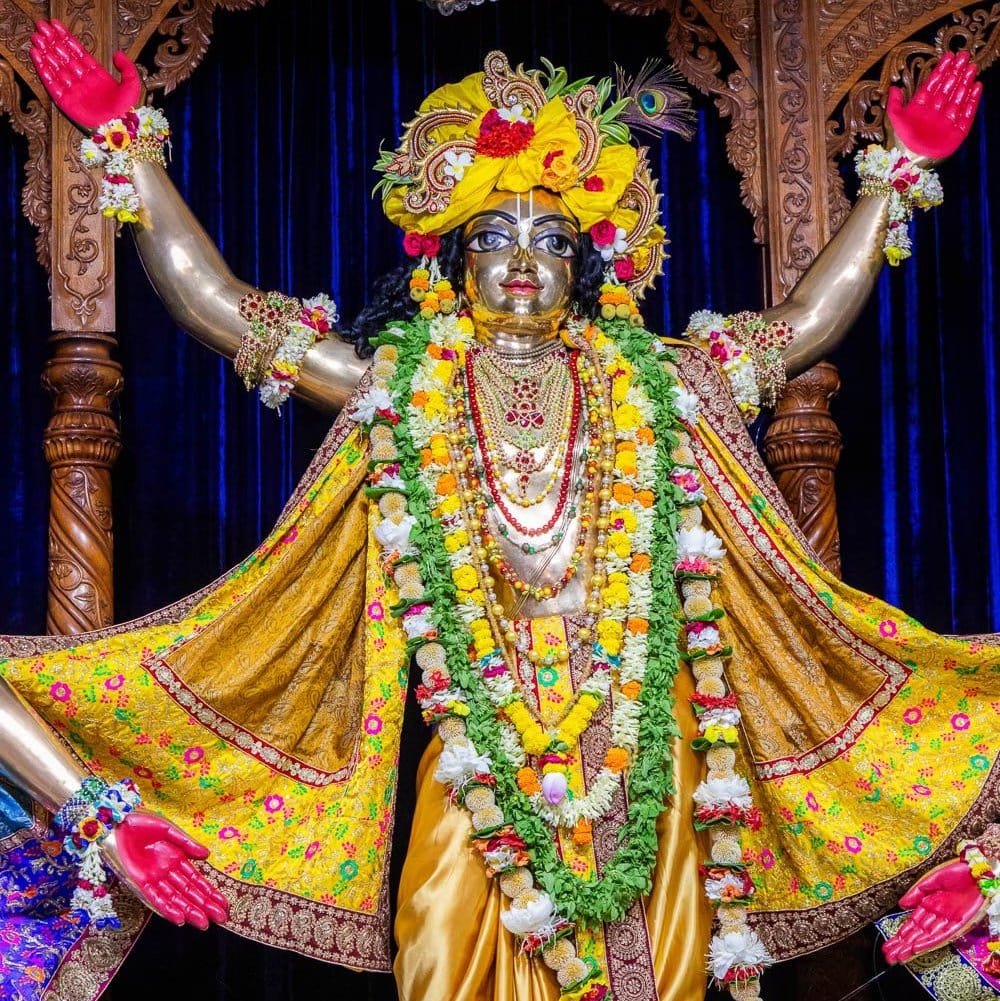
See Krishna Everywhere
The more you make advancement in Krishna Consciousness you will see Krishna everywhere. Not only on the bank of the river, but also on streets, trees, lampposts, and so on. The more you see like that you know you are making tangible advancement in Krishna Consciousness. Actually, there is nothing but Krishna all around us. This is explained in the Gita. He is the taste of water, light of the moon, the fragrance of the flower, light of the sun, sound of the sky, the power of the strong and so on. so one who is actually making progress in Krishna Consciousness, he can see Krishna everywhere. At every stage of life, who can avoid the sunlight, the moonlight, the fragrance of the flower, the taste of the water, the sound of the sky, and so on; but one has to learn it, that there is Krishna in all these varieties of existence.\
(671221 – Letter to Krishna Devi written from San Francisco)
So what is the difference between Brahman, Paramātmā and Bhagavān? That difference is just like the same. If you study, if you become satisfied, “Now I am in the light, sunshine; finished my business,” that is Brahman realization. But that is not final. By Brahman realization you are in the light, that’s a fact. You are in illumination, you are in temperature, that’s a fact. But if you are satisfied with such temperature and light, then you remain there. And if you are fortunate enough to make further progress, that is Paramātmā—to realize the Supersoul in everyone’s heart: in your heart, in my heart, everywhere, all-pervading. Sunshine is also all-pervading. Brahman is also all-pervading. Sarvaṁ khalv idaṁ brahma. Similarly, Paramātmā, the Supersoul, is also all-pervading.
Meditation means to realize the Supersoul, and to realize that Supersoul is everywhere. How everywhere? Aṇḍāntara-stha-paramāṇu-cayāntara-stham (Bs. 5.35). The Supersoul is within this aṇḍa. Aṇḍa means brahmāṇḍa, universe, and everybody up to the atom. He’s within the atom also. Paramāṇu. Paramāṇu means atom. The Supersoul is within the atom. That is the power of God. He can become bigger than the universe. He can put many millions of universes within His belly. At the same time, He can enter within the atom. Aṇor aṇīyān mahato mahīyān. Mahato mahīyān means greater than the greatest and the smaller than the smallest.
Prabhupāda: Hṛd-deśe, He is within your heart. He is within atom. Aṇḍāntara-stha-paramāṇu-cayāntara-stham (BS 5.35). But you have no eyes to see Him. Otherwise, Kṛṣṇa is everywhere. Therefore those who are on the first-class platform of devotional service, they see everywhere Kṛṣṇa. Sthāvara-jaṅgama dekhe, nā dekhe tāra mūrti, sarvatra haya nija iṣṭa-deva-sphūrti (CC Madhya 8.274). He’s seeing to the tree, but he’s not seeing the tree; he’s seeing Kṛṣṇa. That is a difference. Sthāvara-jaṅgama dekhe, nā dekhe tāra mūrti, sarvatra sphūrti. He sees this tree, how it is Kṛṣṇa’s energy, how it is acting. He studies all things as he has studied in the Bhagavad-gītā. Premāñjana-cchurita-bhakti-vilocanena santaḥ sadaiva hṛdayeṣu vilokayanti (BS 5.38). Sadaiva, on account of his love . . . that is a very common sense. If you love somebody, wherever you are, you are seeing your lover, “When I shall meet him? Where he is? What he is doing?” That was the gopīs’ business. Kṛṣṇa was on the pasturing ground, and gopīs are crying at home that, “Kṛṣṇa’s foot is so soft, and He is walking in the fields barefooted. How many, these crags, pricking Him?” In this way thinking, thinking, they were crying. (guest leaves) Hare Kṛṣṇa. That is perfection of Kṛṣṇa consciousness. Satataṁ kīrtayanto māṁ yatantaś ca dṛḍha-vratāḥ (BG 9.14).
(760708 – Conversation C – Washington D.C.)
In Bhagavad-gītā (BG 7.8), Kṛṣṇa explains Himself by saying:
raso ‘ham apsu kaunteya
prabhāsmi śaśi sūryayoḥ
praṇavaḥ sarva-vedeṣu
śabdaḥ khe pauruṣaṁ nṛṣu
“O son of Kuntī [Arjuna], I am the taste of water, the light of the sun and the moon, the syllable om in the Vedic mantras; I am the sound in ether and ability in man.” Here the Lord exhibited His presence everywhere by the tumultuous sound in the sky (śabdaḥ khe). The tumultuous thundering sound was proof of the Lord’s presence. The demons like Hiraṇyakaśipu could now realize the supreme ruling power of the Lord, and thus Hiraṇyakaśipu became afraid. However powerful a man may be, he always fears the sound of a thunderbolt. Similarly, Hiraṇyakaśipu and all the demons who were his associates were extremely afraid because of the presence of the Supreme Lord in the form of sound, although they could not trace out the source of the sound.
(SB 7.8.16 purport)
It is the nature of highly elevated devotees to see Kṛṣṇa in everything,” Lord Caitanya replied. “Whenever they see anything, they do not see the form of that particular thing. They see Kṛṣṇa. This is confirmed in Śrīmad-Bhāgavatam (11.2.45):
- sarva-bhūteṣu yaḥ paśyed bhagavad-bhāvam ātmanaḥ
- bhūtāni bhagavaty ātmany eṣa bhāgavatottamaḥ
” ‘One who is highly elevated in devotional service sees the Supersoul, Kṛṣṇa, who is the Soul of all individual souls.’ A similar passage is found in the Tenth Canto (10.35.9), where it is stated that when Kṛṣṇa came before the creepers, plants and trees of Vṛndāvana, which were laden with flowers and fruits, because He was the Soul of their soul they all bent down in the ecstasy of love for Him and became thorny.
(TLC 32)
A yogī should similarly meditate on the most benevolent smile of Lord Śrī Hari, a smile which, for all those who bow to Him, dries away the ocean of tears caused by intense grief.
(SB 3.28.32)
